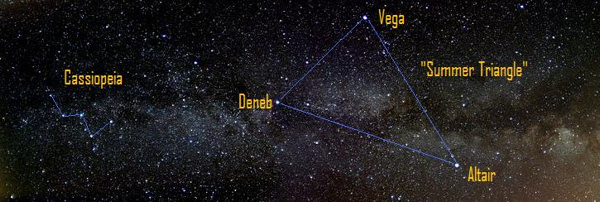
Each year around October 24, the bright star Deneb transits – climbs to its highest point in the sky – around 6:30 p.m. local time (7:30 p.m. local daylight saving time). What does that mean for skywatchers? Only that this noteworthy star – this beloved member of the famous Summer Triangle asterism – is shifting ever-westward in our sky each day, as Earth travels around the sun. Its transit at nightfall in October is a hallmark of the year. It marks a shift toward winter (or summer) on your half of the globe.
At temperate latitudes in the Southern Hemisphere, where it’s now springtime, Deneb transits at or near the same hour by the clock (near 6:30 p.m. local time). Yet, the sun sets later by the clock at more southerly latitudes. What this means is that in the Southern Hemisphere, Deneb at this time of year actually transits when the sun is still up, instead of at dusk/nightfall.
When the sun or a star transits, it resides at one of three places in the sky. It’s either at zenith (straight overhead), north of zenith or south of zenith.
At 45 degrees north latitude (St. Paul, Minnesota, and Turin, Italy), Deneb shines straight overhead when it transits.
At 40 degrees north latitude (Denver, Colorado, and Beijing, China), transits about 5 degrees north of zenith.
At more northerly or southerly latitudes, Deneb either transits to the north or to the south of the zenith point. Appreciably south of 45 degrees north latitude, Deneb lies to the north of the zenith point when it transits; conversely, when Deneb transits at latitudes appreciably north of 45 degrees north latitude, Deneb lies to the southern sky.

Two brilliant stars – Vega and Altair – team up with Deneb to complete the immense Summer Triangle. The luminous Summer Triangle asterism, or star formation, can often be seen in a twilight sky or even from a light-polluted city.
From mid-northern latitudes, the far-northern stars Deneb and Vega are seen at the “top” of the Summer Triangle; meanwhile, the southernmost star Altair shines at the “bottom.” From tropical northern latitudes and from the Southern Hemisphere, it’s the other way around: Altair reigns at top and Deneb at bottom. It’s a matter of perspective.
Vega, the Summer Triangle’s westernmost star, lies to the right of Deneb from mid-northern latitudes. From tropical northern latitudes and from the Southern Hemisphere, on the other hand, Vega lies to the left of Deneb.
Around the world, the stars of the Summer Triangle transit some four minutes earlier with each following day (or two hours earlier with each following month). So, from northerly latitudes, the Summer Triangle is destined to shift over into the western sky at nightfall as autumn ebbs toward winter … or, for those in the Southern Hemisphere, as spring blooms into summer.

Bottom line: As darkness falls in mid-October, the star Deneb shines at the apex of the sky at mid-northern latitudes.
Enjoying EarthSky so far? Sign up for our free daily newsletter today!
The post Bright star Deneb transits at dusk around October 24 first appeared on EarthSky.
0 Commentaires